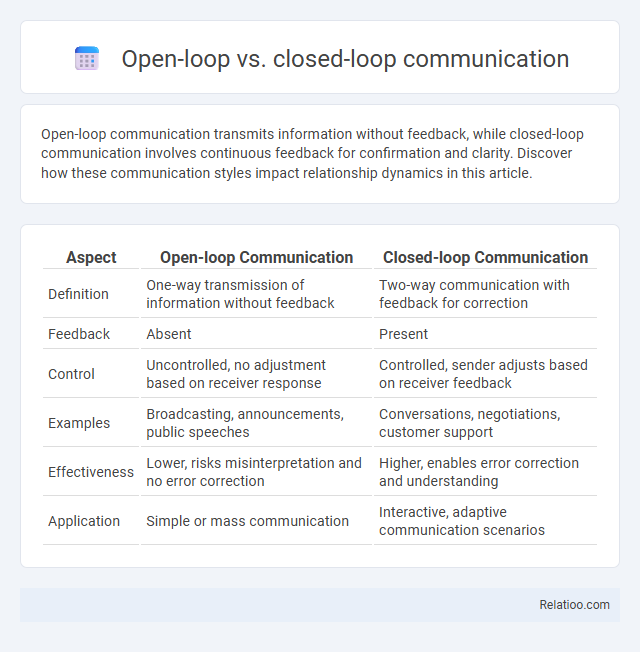Open-loop communication transmits information without feedback, while closed-loop communication involves continuous feedback for confirmation and clarity. Discover how these communication styles impact relationship dynamics in this article.
Table of Comparison
| Aspect | Open-loop Communication | Closed-loop Communication |
|---|---|---|
| Definition | One-way transmission of information without feedback | Two-way communication with feedback for correction |
| Feedback | Absent | Present |
| Control | Uncontrolled, no adjustment based on receiver response | Controlled, sender adjusts based on receiver feedback |
| Examples | Broadcasting, announcements, public speeches | Conversations, negotiations, customer support |
| Effectiveness | Lower, risks misinterpretation and no error correction | Higher, enables error correction and understanding |
| Application | Simple or mass communication | Interactive, adaptive communication scenarios |
Understanding Open-Loop and Closed-Loop Communication
Open-loop communication involves a unidirectional flow where the sender transmits a message without expecting or receiving any response from the receiver, common in broadcasting systems. Closed-loop communication features a two-way interaction where the sender receives feedback, enabling message adjustment and ensuring clarity, often used in command-and-control systems. Understanding the distinction highlights that closed-loop communication enhances accuracy and effectiveness by incorporating real-time feedback, unlike the fixed nature of open-loop communication.
Key Concepts of Communication Loops
Open-loop communication operates without system feedback, transmitting information in a single direction, often leading to limited adaptability. Closed-loop communication integrates continuous feedback, allowing the sender and receiver to adjust the message dynamically for clarity and effectiveness. Understanding your role within these loops is essential for improving message accuracy and ensuring effective information exchange through feedback mechanisms.
Structure of Open-Loop Communication
Open-loop communication features a unidirectional message flow from sender to receiver without real-time feedback, relying on predefined signals or instructions. The structure of open-loop communication includes a clear sender, a specific message, and a designated receiver who acts without influencing the initial transmission. Your understanding of this structure is crucial for systems where feedback is unnecessary or impractical, such as automated broadcasts or emergency alerts.
Structure of Closed-Loop Communication
Closed-loop communication involves a structured exchange where the sender transmits a message, the receiver confirms receipt by repeating or clarifying it, and the sender verifies the accuracy to ensure mutual understanding. This triadic process minimizes errors by creating a feedback mechanism within the communication cycle, distinguishing it from open-loop communication, which lacks this confirmation step. The closed-loop structure is critical in high-stakes environments like healthcare and aviation, where precise and unambiguous information transfer prevents mistakes and enhances safety.
Comparing Open-Loop and Closed-Loop Models
Open-loop communication operates without feedback, sending information from sender to receiver with no mechanism to confirm message reception or understanding. Closed-loop communication incorporates feedback, enabling the sender to adjust messages based on receiver responses, enhancing accuracy and effectiveness. In contrast, feedback loops emphasize continuous, real-time interaction for dynamic system regulation, making closed-loop models more adaptive and reliable than open-loop systems.
Advantages of Closed-Loop Communication
Closed-loop communication enhances accuracy and clarity by ensuring messages are confirmed and understood, reducing errors in critical tasks. It creates a feedback loop where the receiver actively acknowledges and repeats the information, reinforcing retention and accountability. Your interactions benefit from improved coordination, making closed-loop communication ideal for high-stakes environments like healthcare and aviation.
Limitations of Open-Loop Communication
Open-loop communication lacks real-time feedback, making it difficult to verify whether Your message is correctly received or understood, which can lead to misinterpretations and errors. This unidirectional flow limits the ability to adjust or correct information dynamically, reducing the effectiveness in complex or rapidly changing environments. In contrast, closed-loop communication and feedback loops enable continuous information exchange, improving accuracy and responsiveness.
Real-World Applications and Examples
Open-loop communication systems, like broadcast radio, transmit information without expecting a response, often used in mass media and emergency alerts. Closed-loop communication enables two-way interaction, essential in aviation cockpit exchanges and customer service call centers to ensure message clarity and error correction. Feedback loops, integral to control systems such as thermostats or autonomous vehicles, continuously monitor outputs to adjust inputs, enhancing system stability and performance in dynamic environments.
Choosing the Right Communication Approach
Choosing the right communication approach involves understanding the distinctions between open-loop, closed-loop, and feedback loop systems. Open-loop communication allows information to flow in one direction without real-time adjustments, suitable for straightforward tasks with minimal interference. Closed-loop and feedback loop methods emphasize continuous monitoring and response, enhancing accuracy and adaptability in dynamic environments, ensuring Your message is received and appropriately addressed.
Enhancing Communication Effectiveness
Open-loop communication involves a one-way transmission of information without response, while closed-loop communication includes acknowledgment and confirmation to ensure message clarity. Feedback loops further enhance communication effectiveness by allowing real-time adjustments based on the receiver's input, minimizing misunderstandings. You can improve your communication skills by actively engaging in closed-loop and feedback mechanisms to create a more interactive and accurate information exchange.

Infographic: Open-loop vs Closed-loop communication
 relatioo.com
relatioo.com